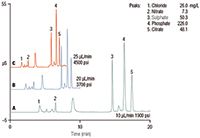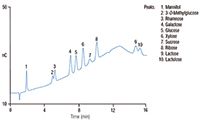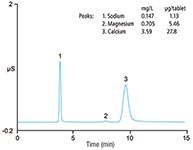Capillary Ion Chromatography Gains Momentum
The first commercial capillary ion chromatography (IC) systems became available in 2010, but uptake of the technique has been slow even though it has many benefits. Here, we review those benefits and present selected application areas where it is proving especially useful.
Since the introduction of ion chromatography over 30 years ago, there has been much progress in the development of innovative IC systems. Capillary IC was introduced to provide a technique that is always ready and provides excellent eluent and waste economy. The first commercial capillary IC systems became available in 2010, but uptake of the technique has been slow, even though it has many benefits. This article assesses these benefits and presents selected application areas where capillary IC is proving especially useful.
There are a number of benefits to capillary ion chromatography (IC):
Continuous Operation: A capillary IC system is always ready to run samples. Column size, injection volumes, and flow rates are scaled down by a factor of 10 to 100 in capillary IC compared to conventional flow systems, thereby improving system stability and reducing the need for recalibration. A continuous mode of operation is possible because capillary IC systems only consume 15 mL of water per day or 5.2 L a year.

Photo Credit: Pete Gardner/Getty Images
Less Waste: The waste produced in a capillary IC system is minimized, thereby reducing disposal costs. When operated as a "reagent-free" ion chromatography (RFIC) system, the eluent generation cartridge can last for 18 months of continuous operation. When using eluent generation, only water flows through the pumps, extending the life of seals and decreasing the cost of maintenance compared to other mobile phases. Advances in eluent generation and electrolytic suppression technologies enable a wider variety of applications and increased productivity. RFIC systems combine automated eluent generation and electrolytically regenerated suppression technology to create the required eluents and regenerants used for IC applications. Laboratories using RFIC systems spend less time on equilibration, calibration, method verification, troubleshooting, and consistency checks because the technology minimizes unintentional variations in the preparation of eluents and regenerants.
Lower Sample Volume: Capillary IC operated as a RFIC system can provide trace-level determinations using sample volumes of up to 250 µL. One approach is to perform a large-volume direct injection that is suitable for samples with low levels of matrix ions. A 10 µL injection onto a 0.4-mm i.d. column in a capillary IC system is equivalent to a 1000 µL injection onto a 4-mm i.d. column. An alternative approach is to load a 250 µL sample onto a capillary concentrator rather than loading a 25-mL sample onto a 4-mm concentrator. Capillary IC can offer significant benefits in trace analysis where sample volumes might be limited.
Higher Resolution: Capillary IC can be performed under high pressure at up to 5000 psi when configured as an RFIC system. These high-pressure capillary IC systems can support higher back pressure 4-µm particle ion exchange columns. The advantage of using a 4-µm particle ion exchange column is improved chromatographic efficiency because of the smaller particle size. A 150-mm length column can be used at higher flow rates to increase productivity; a 250-mm length column can provide higher resolution separations of complex sample matrices.
Selected Capillary IC Applications
The selected application examples discussed here demonstrate the benefits of capillary IC as a technology in various markets. However, the benefits of capillary IC are not limited to just these applications:
Environmental: Perchlorate is an environmental contaminant found in drinking, ground, and surface waters. It can interfere with thyroid iodine uptake, inhibiting thyroid function. Two-dimensional (2D) IC can be performed to determine trace concentrations of perchlorate in drinking waters using the capillary format in the second dimension. 2D IC can be applied where matrix diversion or matrix elimination are required prior to analysis of trace components and has a number of advantages. Initial sample loading onto a 4-mm column allows a large volume of sample to be loaded and also allows for higher selectivity of the analytes of interest relative to the matrix ions. In addition, it is possible to focus an analyte peak that is partially resolved in the first dimension onto a concentrator column in the second dimension as shown in Figure 1. By using a capillary format in the second dimension there is an improvement in the detection sensitivity of perchlorate.

Figure 1: Chromatogram of a 2 µg/L perchlorate standard in reagent water in the second dimension.
Food and Beverage: The beverage industry is required to determine quantities of organic acids used as acidulants and flavouring agents to meet product labelling requirements in 21 CFR part 101. Organic acid determinations can be performed using higher flow rates on a high-resolution column and a high pressure capillary IC system, as shown in Figure 2. Sample throughput is increased by increasing the flow rate, which saves money and labour. Additional calibration time is eliminated because the operating system is always ready.

Figure 2: Fast separations of anions in a diet cola beverage by high-pressure capillary IC.
Biopharmaceuticals:
Capillary HPAE–PAD: It is difficult to detect carbohydrates with UV absorption without lengthy and costly derivatization. However, carbohydrates can be determined directly by high performance anion-exchange chromatography with pulsed amperometric detection (HPAE–PAD), a well-established technique that eliminates the need for derivatization. Certain carbohydrates, such as mannitol, rhamnose, xylose, 3-O-methylglucose, and lactulose, are studied by researchers in both urine and serum samples to evaluate disease states. Capillary IC can provide measurements using relatively small volumes. As an example, mono- and disaccharides in synthetic urine can be determined by capillary IC as demonstrated in Figure 3.

Figure 3: Carbohydrates of interest for urine analysis.
Capillary IC–MS: Therapeutic nucleosides and nucleotides are essential for determining drug efficacy and toxicity. Viral or cell proliferation is inhibited when these compounds are phosphorylated intracellularly to pharmacologically-active nucleoside triphosphates. Nucleotides are commonly analyzed by techniques using ion-exchange chromatography or ion-pair reversed-phase high performance liquid chromatography (HPLC) because of their strong hydrophilic nature. Capillary IC coupled to tandem mass spectrometry (IC–MS–MS) offers unique chromatographic selectivity for polar metabolites and can be used as a complementary technique to reversed-phase LC–MS as shown in Figure 4.

Figure 4: Chromatograms of nucleotide Q-SRM transitions.
Pharmaceuticals: Figure 5 shows the use of capillary IC to provide ultrafast separations of inorganic anions and cations relevant to the pharmaceutical industry. Counterions relevant to the pharmaceutical industry are separated by capillary ion-exchange chromatography and detected with high sensitivity by suppressed conductivity using capillary IC.

Figure 5: Counter-ion determinations in an atorvastatin calcium tablet by capillary IC.
Conclusions
A capillary IC system is always ready to run samples as soon as they are prepared. In addition, these systems dramatically minimize waste production in turn providing an environmentally friendly solution for labs.
References
1. Thermo Fisher Scientific. Whitepaper 70924: Highlighted Capillary IC Applications http://www.dionex.com/en-us/webdocs/115165-WP70924-CapIC-Applications-Final.pdf
2. Thermo Fisher Scientific. Whitepaper 70552: What Is Capillary Ion Chromatography? http://www.dionex.com/en-us/webdocs/114250-WP-What-is-Cap-IC-WP70552_E.pdf
3. Dionex Homepage (http://www.dionex.com/en-us/products/ion-chromatography/ic-rfic-systems/ics-5000/lp-72594.html)
4. Dionex Homepage (http://www.dionex.com/en-us/products/ion-chromatography/ic-rfic-solutions/capillary-ic/always-on-ready/lp-88647.html)
5. Dionex Homepage (http://www.dionex.com/en-us/products/ion-chromatography/ic-rfic-solutions/capillary-ic/columns/lp-88588.html)
6. Thermo Fisher Scientific. Application Note 1024: Improved Determination of Trace Perchlorate in Drinking Water Using 2D-IC. http://www.dionex.com/en-us/webdocs/113927-AN1024-IC-Trace-Perchlorate-Drinking-Water-2D-IC-AN70213_E.pdf
7. Thermo Fisher Scientific. Technical Note 118: Fast Separations of Anions and Organic Acids in a Carbonated Beverage Using High-Pressure Capillary IC. http://www.dionex.com/en-us/webdocs/114239-TN118-HPIC-Anions-OA-Carbonated-Beverages-TN70167_E.pdf
8. Thermo Fisher Scientific. Technical Note 137: Determination of Carbohydrates in Urine by Capillary HPAE-PAD. http://www.dionex.com/en-us/webdocs/114657-TN137-CapIC-HPAE-PAD-CHO-Urine-TN70696_E.pdf
9. Thermo Fisher Scientific. Application Note 2967: Implementation of a Walk-Up High-Pressure Capillary Ion Chromatograph for the Fast Separation of Pharmaceutical Relevant Inorganic Anions and Cations. http://www.dionex.com/en-us/webdocs/114929-AN2967_E_09-12C_-_DIONEX-IC_Cap_Fast_Pharma-
10. Thermo Fisher Scientific. Application Note 575: Quantitative Profiling of Nucleotides Using Capillary IC-MS/MS. https://static.thermoscientific.com/images/D21721~.pdf
Mike Doyle is a Sr. Product Manager for Thermo Scientific IC Systems. His work involves the development, promotion, and support of laboratory and process analytical solutions across a variety of industries.
Monika Verma is a Product Marketing Specialist at Thermo Fisher Scientific. She supports the Thermo Scientific Ion Chromatography & Sample Preparation products in Sunnyvale, California.
RFIC is a trademark of Thermo Fisher Scientific.
E-mail: mike.doyle@thermofisher.com
Website: http://www.thermoscientific.com/en/about-us/videos/capillary-ion-chromatography.html
This article is from The Column. The full issue can be found here:http://images2.advanstar.com/PixelMags/lctc/digitaledition/July07-2014-uk.html#2

Polysorbate Quantification and Degradation Analysis via LC and Charged Aerosol Detection
April 9th 2025Scientists from ThermoFisher Scientific published a review article in the Journal of Chromatography A that provided an overview of HPLC analysis using charged aerosol detection can help with polysorbate quantification.
Removing Double-Stranded RNA Impurities Using Chromatography
April 8th 2025Researchers from Agency for Science, Technology and Research in Singapore recently published a review article exploring how chromatography can be used to remove double-stranded RNA impurities during mRNA therapeutics production.










